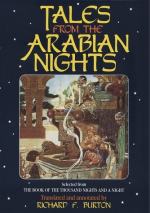Contes Tartares (W. iii.).
22, 23. Les Sultanes de Guzerath, ou les Songes des hommes eveilles. Contes Moguls (W. iii.). 25. Nouveaux Contes Orientaux, par le Comte de Caylus (W. ii.). 29, 30. Les Contes des Genies (W. iii.). 30. Les Aventures de Zelouide et d’Amanzarifdine. 30. Contes Indiens par M. de Moncrif. 33. Nourjahad (W. ii.). 34. Contes de M. Pajon. 38-41. Les Veillees du Sultan Schahriar, &c. (Chavis and Cazotte; cf. antea, p. 419; W. i. ii.).
(Weber also includes, in his vol. ii. Nos. 21a, 22, 32 and 37, after Caussin de Perceval.)
12, 13. The Adventures of Abdallah, the Son of Hanif (Class 5 or 6).
Originally published in 1713; attributed to M. de Bignon, a young Abbe. A series of romantic travels, in which Eastern and Western fiction is mixed; for instance, we have the story of the Nose-tree, which so far as I know has nothing Oriental about it.
16. The Voyages of Zulma in Fairy Land (Class 4).
European fairy tales, with nothing Oriental about them but the names of persons and places. The work is unfinished.
17, 18. The Tales of Bidpai (translated by
Galland) are Indian,
and
therefore need no further notice here.
19-23. Chinese, Tartarian and Mogul Tales (Class 6).
Published in 1723, and later by Thomas Simon Gueulette.
Concerning these tales, Mr. Clouston remarks (in litt.): “Much of the groundwork of these clever imitations of the Arabian Nights has been, directly or indirectly, derived from Eastern sources; for instance, in the so-called Tartar tales, the adventures of the Young Calender find parallels, (1) in the well-known Bidpai tale of the Brahman, the Sharpers and the Goat (Kalila and Dimna, Panchatantra, Hitopadesa, &c.) and (2) in the worldwide story of the Farmer who outwitted the Six Men (Indian Antiquary, vol. 3) of which there are many versions current in Europe, such as the Norse tale of Big Peter and Little Peter, the Danish tale of Great Claus and Little Claus; the German tale (Grimm) of the Little Farmer; the Irish tale of Little Fairly (Samuel Lover’s collection of Irish Fairy Legends and Stories); four Gaelic versions in Campbell’s Popular Tales of the West Highlands; a Kaba’il version in Riviere’s French collection (Contes populaires Kabylies); Uncle Capriano in Crane’s recently published Italian Popular Tales; and a Latin mediaeval version (written probably in the I **1th century) in which the hero is called ‘Unibos,’ because he had only one cow.”
25. Oriental Tales (Class 6).
Mr. Clouston observes, “Appeared in 1749,[FN#472] and on the title page are said to have been translated from MSS. in the Royal French Library. The stories are, however, largely the composition of De Caylus himself, and those elements of them which are traceable to Asiatic sources have been considerably Frenchified.”




